In 2021, Hanzhi Tang explained the visual effects work created by Digital Domain on Black Widow. He then worked on Shang-Chi and the Legend of the Ten Rings.
Ellen Hoffmann has been working in animation for over 15 years. She joined the Digital Domain team in 2013 and has worked on projects such as Beauty and the Beast, Avengers: Infinity War, Stranger Things and Ms. Marvel.
What was your feeling about entering Wakanda?
Hanzhi Tang (HT): We were very proud to have been asked to join this project and revisit the characters from Black Panther. We had a great deal of respect for Ryan Coogler and the complexity of the task ahead of us. So much fantastic world building had been done in the first film and we had to make sure that continued into this new story.
How was the collaboration with Director Ryan Coogler and the VFX Supervisor Geoffrey Baumann?
HT: We worked with Geoffrey Baumann before on Black Widow, and we have a great working relationship with him. There’s a level of trust going both ways in how we work and what the goals will be. Geoffrey was a great bridge for us working with Ryan Coogler for the first time. Both on set and in post-production, Ryan was a pleasure to work with and inspired you to give your best effort.
What were their expectations and approach towards the visual effects?
HT: One of the main rules we tried to stick to on this film was to minimize the use of bright and magical looking energy effects that might draw us away from realism. This covered everything from engines to thrusters and weapons fire. One of the other mainstays of this film was a unique look designed by DoP Autumn Durald Arkapaw. In addition to the lighting design, we had to match the live action photography that used modern Panavision lenses – which were custom detuned to give a mix of flaring and lens phenomena – and harkened back to more vintage lenses.
How did you organize the work with your VFX Producer?
HT: From the beginning of the movie, our producer Amy James-Wang and I started planning out the delivery schedule based off of what we knew from the previz. We also were awarded a lot of assets that would need to be shared with the other vendors. Those would have to be done on a relatively strict schedule in order to not hold up other VFX work. Once I came back from set, we started planning out the final schedule based on resource and time intensive plate prep work. We also tried to get as much FX development done and locked away before the shot work landed. From experience, we also did our best to plan around eleventh hour requests as the final movie took shape.
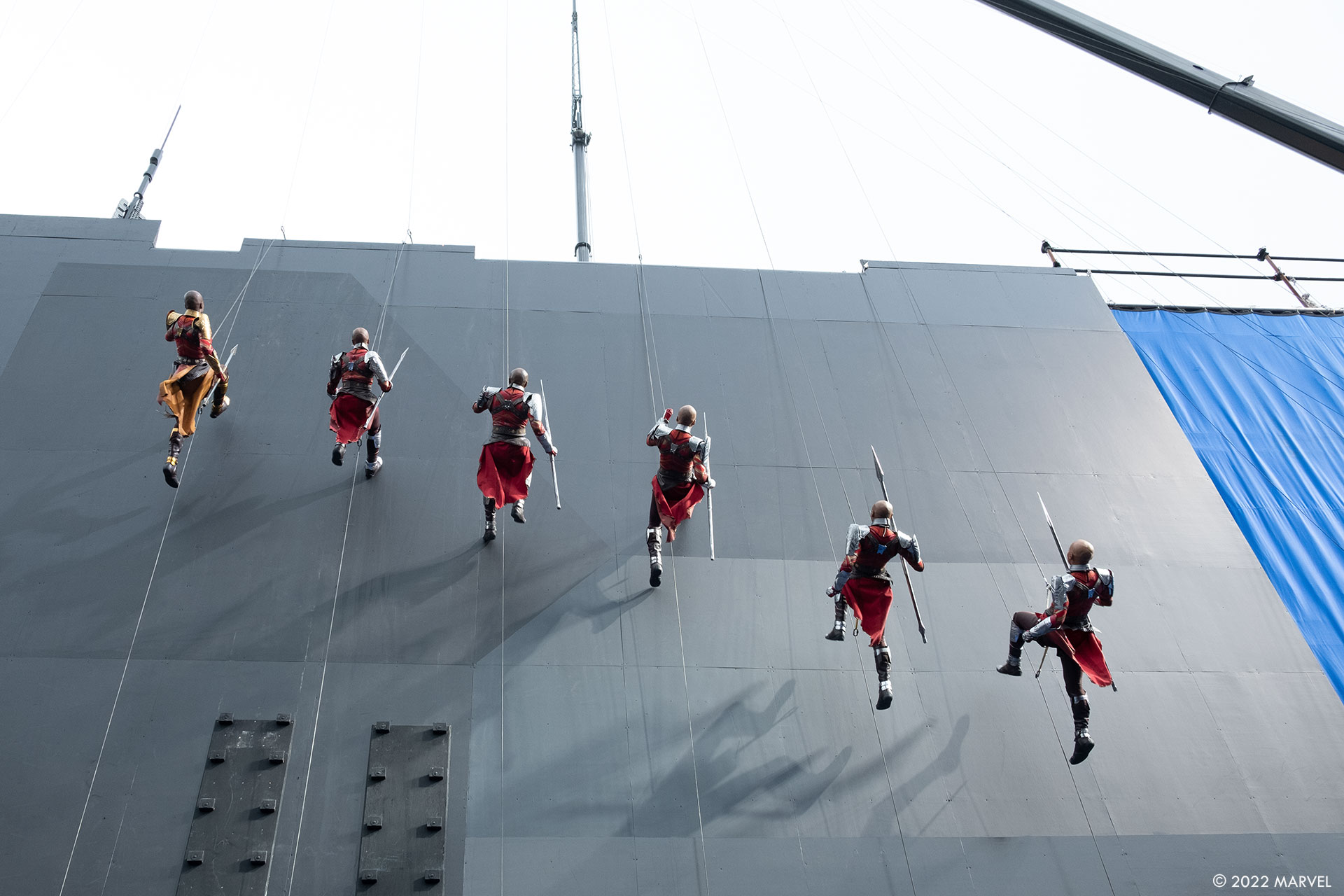
What are the sequences made by Digital Domain?
HT: The main scope of our work was the ocean battle aboard the Royal Sea Leopard and the fight in the desert. We also helped extend Jabari Land for the city evacuation shots and introduce the new Black Panther for the first time in the Jabari Tribal Council
Can you explain in detail about the recreation of Jabari Land?
HT: We started with the beautiful asset from RISE that had been built for the first movie, and we extended out the back valley into a new area that would house the evacuees. We built all new habitat pods and layouts, and created snow drifts and crowds to populate this place of refuge.
How did you populate this environment with crowds and ships?
HT: Jabari Land was an environment that we modeled in Maya and rendered in Houdini Solaris. It made integrating with the Houdini crowd system and snow effects quite effective and efficient compared to our traditional Maya-Houdini hybrid workflow. Since Solaris is still quite new at Digital Domain, we kept the animated vehicles in Maya.
Can you elaborate about the design and creation of the new Black Panther?
HT: Yes! With a new Black Panther came a new suit. This new suit design was obviously customised to Shuri and she brought her own distinctive touches to the style and shape of the suit. Everything from the array of dots on the costume that mimic her trademark battle makeup, to the new sleeker Panther gauntlets became part of her suit. The color choices now add metallic finishes and gold to her claws. There were multiple practical suits fabricated for the stunt actors and principal actress Letitia Wright. We created our digital suit from photogrammetry and texture captures provided by Clear Angle Studios, matching both the primary stunt double and Letitia in case we needed to do a partial or complete replacement of any plate later on.
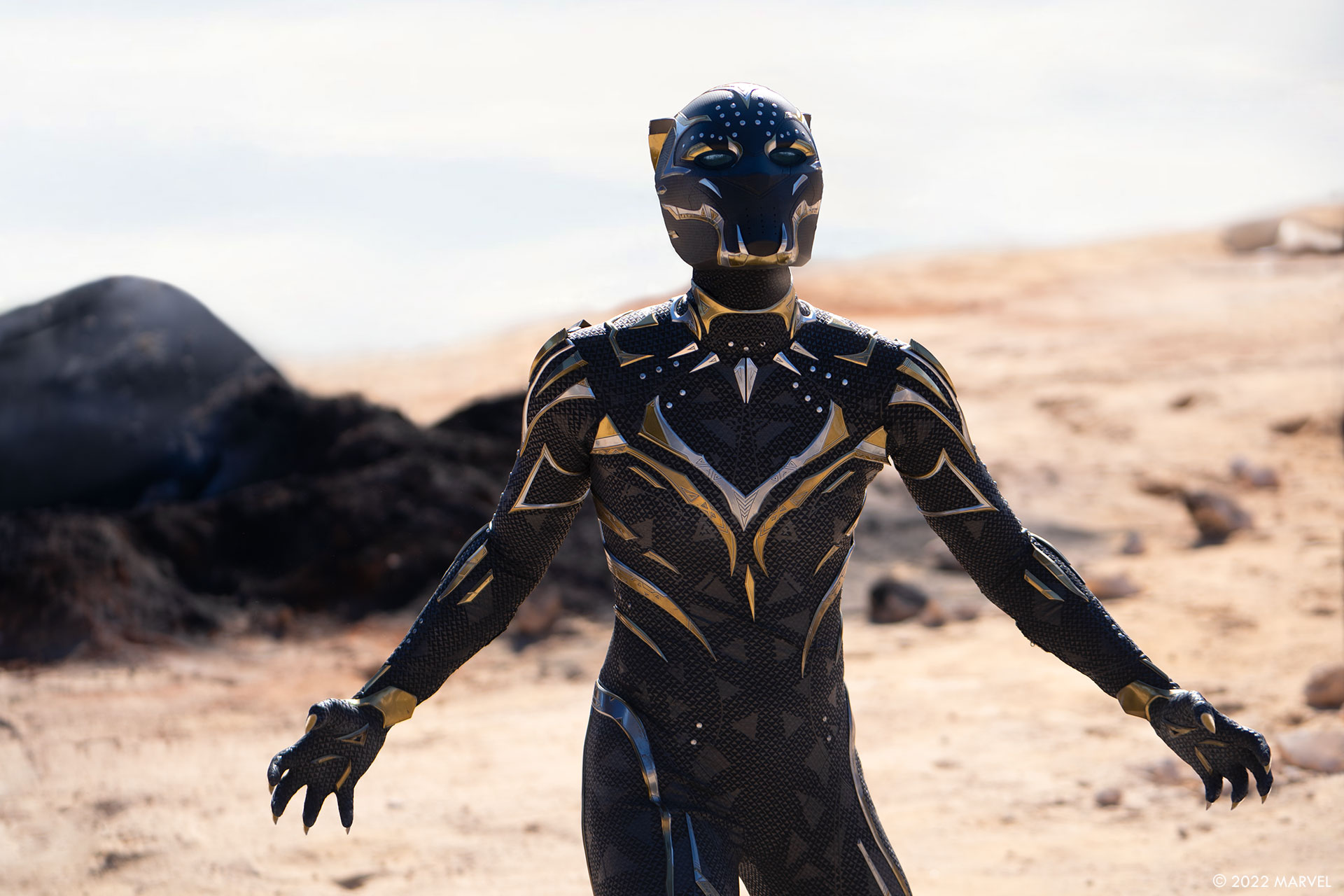
How did you handle the challenge of giving her strength and weight?
HT: We looked at a lot of different speed climbing competition references, but Ellen, our Animation Supervisor knows more.
Ellen Hoffmann (EH): We looked at female climbers and acrobats, who tend to have leaner bodies with a high strength to weight ratio that provides good balance and flexibility. With the momentum of a dynamic swing and jump, she accumulates power and transfers the energy through her body to kick, push and pull the Talokanil from the boat.
What were the main challenges with this Black Panther?
HT: The first challenge was making sure we matched the practical costume as closely as possible. After that, it was smaller things like figuring out how the helmet transitions would progress and where we would hide the source and end points of the suit nanotech. Also, we didn’t want the helmet to look oversized like a motorbike helmet, so we had to slim it down as much as possible and make it tight fitting to the face.
What was your approach with the final battle?
HT: The final battle was a big sequence with many different fights and heroic moments. We had to break that down into smaller teams so artists could get some momentum going on specific elements like water interaction or the look of flying and clouds. At peak production, we were generating a few thousand items a week to be reviewed, and that needed to be delegated to make it mathematically possible. We also approached the third act by sending production editorial a decent version as quickly as possible that would help precipitate editorial choices instead of pushing any single thing too far and having it omitted later. It pays to stay as fluid as possible in these situations.
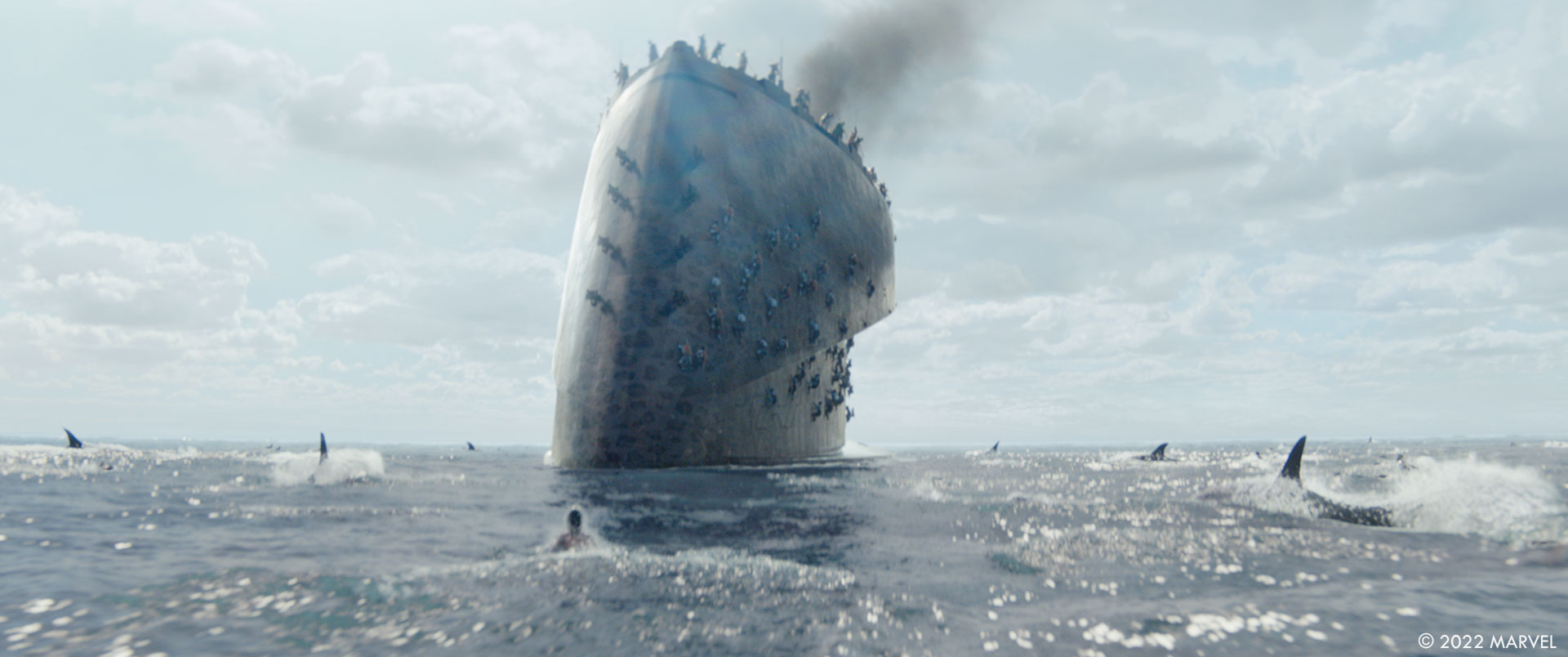
How did you create the massive ship?
HT: The ship went through a number of iterations, but we started with the art department and previz models for scale. We went through a number of design phases to figure out the surface type and the leopard spot pattern that Hannah Beachler wanted as a signature design element. The scale and overall shape were pretty locked in, so we were just responsible for detailing out the surfaces that we would be close up on and making it work in production. For example, we had to figure out which parts of the ship could actually be climbed. We had to make a custom section with a flatter hull that better matched the climbing wall we already shot plates of. Otherwise, all the handholds would appear to slip.
Can you elaborate on the design and creation of Iron Heart and the Midnight Angels?
HT: Iron Heart exists as a couple of different suits in the movie. For our third act sequence, she would appear in a newly fabricated Mk2 suit that was based off production artwork, a physical suit by Legacy Effects and a 2 foot maquette. Our model was based on scans of both the practical suit – which was just the helmet down to the chest plate – and the maquette, which gave us proportions for the lower half.
The Midnight Angels followed a similar path. Production had fabricated full costumes and helmets that could be worn by Danai Gurira and Michaela Coel, which were then fully scanned and photographed. They weren’t always practical to act or do stunts in, so we would do partial or full CG replacements as necessary. From what I know about the comic book version, our Midnight Angel design is quite true to the original comic design.
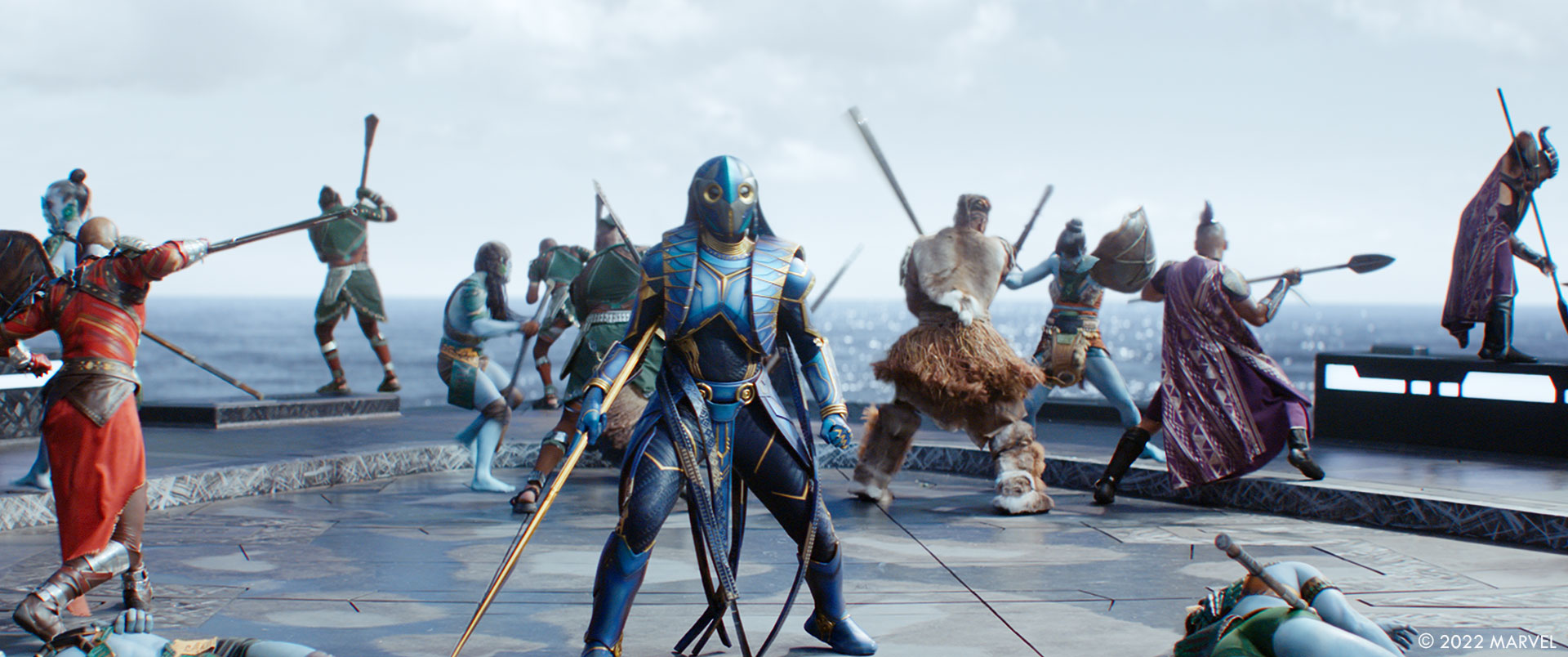
How did you create the two armies?
HT: We created many different costume variations for the different Wakandan tribes and roles, from navy officers to Jabari or Dora Milaje. On the Talokanil side, we created male and female variants from the stunt actors on set with different costume pieces and each with different cloth sims. These were then used as both hero Maya animated characters or background extras that were animated using our Houdini crowd tools. Animation in general was assembled from hand key framed cycles or clips of fighting mocap. We also had to create crowds in the water and those were almost entirely hand animated swim cycles.
Can you tell us more about the intense final fight?
HT: In the final edit, you have multiple fights taking place and they’re all intercut and frantic. It mirrored a lot of the work going on too. We had so many different characters in animation, all going at the same time, with matchmoves and cameras dropping in hour by hour and everything needing a cloth sim. It was an intense experience. I really have to thank the FX department for every time we changed the animation on the swimmers.
EH: We had a huge amount of different actions. Talokanil fighting on the boat and in the water, Namora wrestling Ironheart, Ironheart chasing Namor in the air, Black Panther and Namor fighting on the island and so many more. Every hero had their own characteristic body motion.
Different body proportions for every background character made it challenging to reuse animation. A smaller person could not fully do the same action like a larger person; it would have not looked believable. We changed the mocap to match the size, body shape and specific weapon techniques of each character. Additionally, we prepared cycles for our crowd team so they could populate the far background.
Ironheart’s strength comes from her suit, so it needed to be more on the mechanical side. Namor, on the other hand, was holding on to Ironheart using her own body strength.
Namor had a very special way of pushing himself through the air with the help of his wings, and fighting with his spear.
Black Panther had the power of her suit and the legacy powers, including using her claws in a melee fashion to cut.
In the end, the challenge was tying all the different types of characters and body motion together, and making them recognizable and distinct with so much going on.
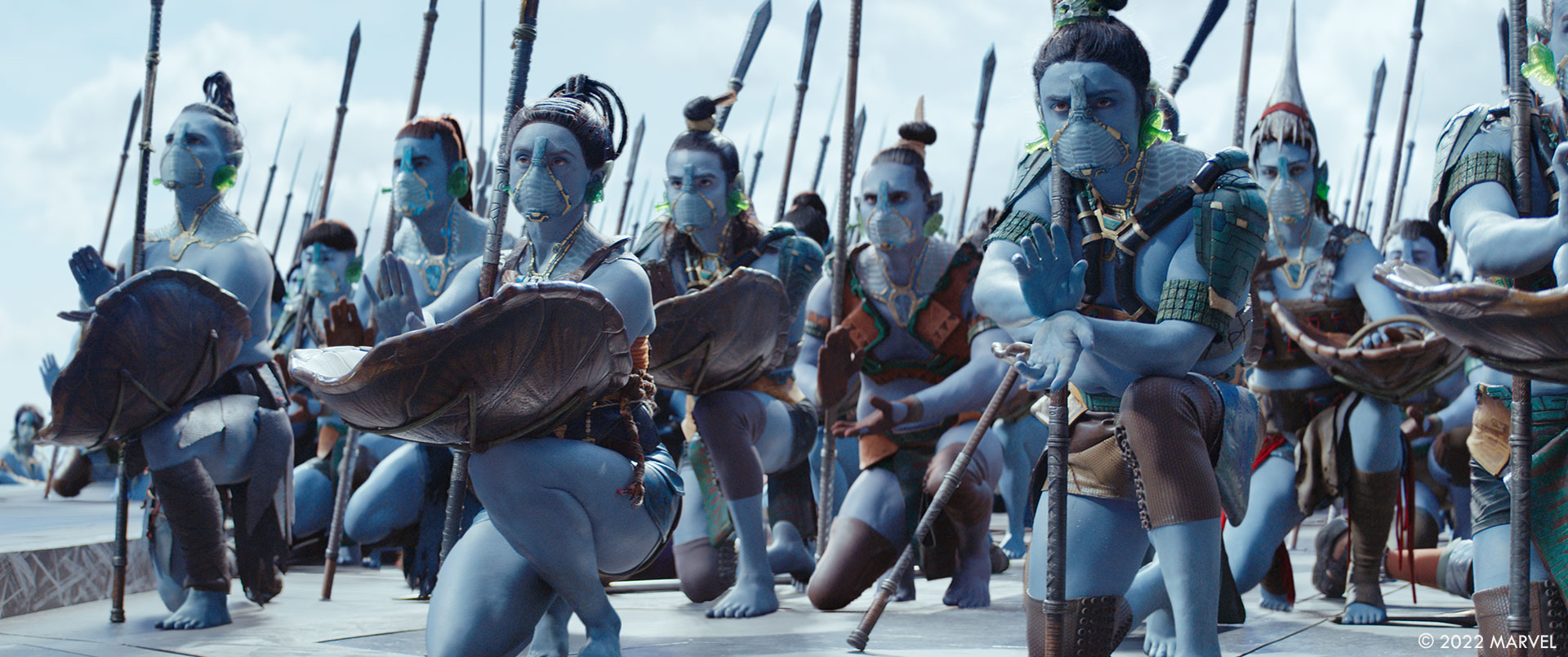
How did you create the digital doubles?
HT: The digidoubles all followed a fairly standard process for us. We started from the texture and photogrammetry that was captured by Clear Angle Studios on set. From that we modeled, textured and look developed matching to those photographs before testing in HDR environments that were specific to our sequences. I realised it’s easy to overlook some metallic paints and materials that aren’t obvious when presented with even a large set of stills. Even small video clips of view dependent materials helped clarify to the lookdev artist exactly what’s happening. Otherwise, matte silvers and subtle varying surfaces can be mistaken for plain grey or white in still photos.
Can you tell us more about the environments?
HT: Jabari Land was only used in a few shots to establish location, but we had to do an extensive build of a new area for it. We built out all the assets and people so we could fill the refuge area after people from the city were evacuated. We built modular habitat units that had cool tribal colors and designs that Ryan Coogler had picked out, and we modeled all the civilian crowd costumes from scans of the Golden City extras.
Our other big environment build was the desert where Shuri and Namor fight. Conceptually, it was based on coastal Atacama desert, but we also used aerial photogrammetry from Death Valley and Trona Pinnacles to generate rock shapes and hillsides. This was then blended back into plate photography that we shot at a sand quarry in Atlanta, with a few all-CG shots when we went wide.
The Royal Sea Leopard in the ocean is really its own environment too, but that was an all-CG build with FX ocean and an extension of the flat bit of deck that had been built for the actors.
Which shot or sequence was the most challenging?
EH: I think we had one shot which in my eyes was the most challenging, when Black Panther jumps from the boat to a fly-by of the Royal Talon Fighter. The motion of the spaceship defined the Black Panther jump and the camera movement. Additionally, we had Dora Milaje hanging on ropes with their own special fighting techniques in the background, and Talokanil climbing up fighting and falling from the boat hull.
Is there something specific that gives you some really short nights?
HT: We were always chasing the calendar because of the amount of really intricate and difficult rotoscoping, tracking and paint work that needed to be done in our sequence. This work is generally hard to accelerate, so we spread it out as much as possible amongst some partner vendors. Manifesting the folding of space and time to stay on schedule might have given me reason to lose sleep.
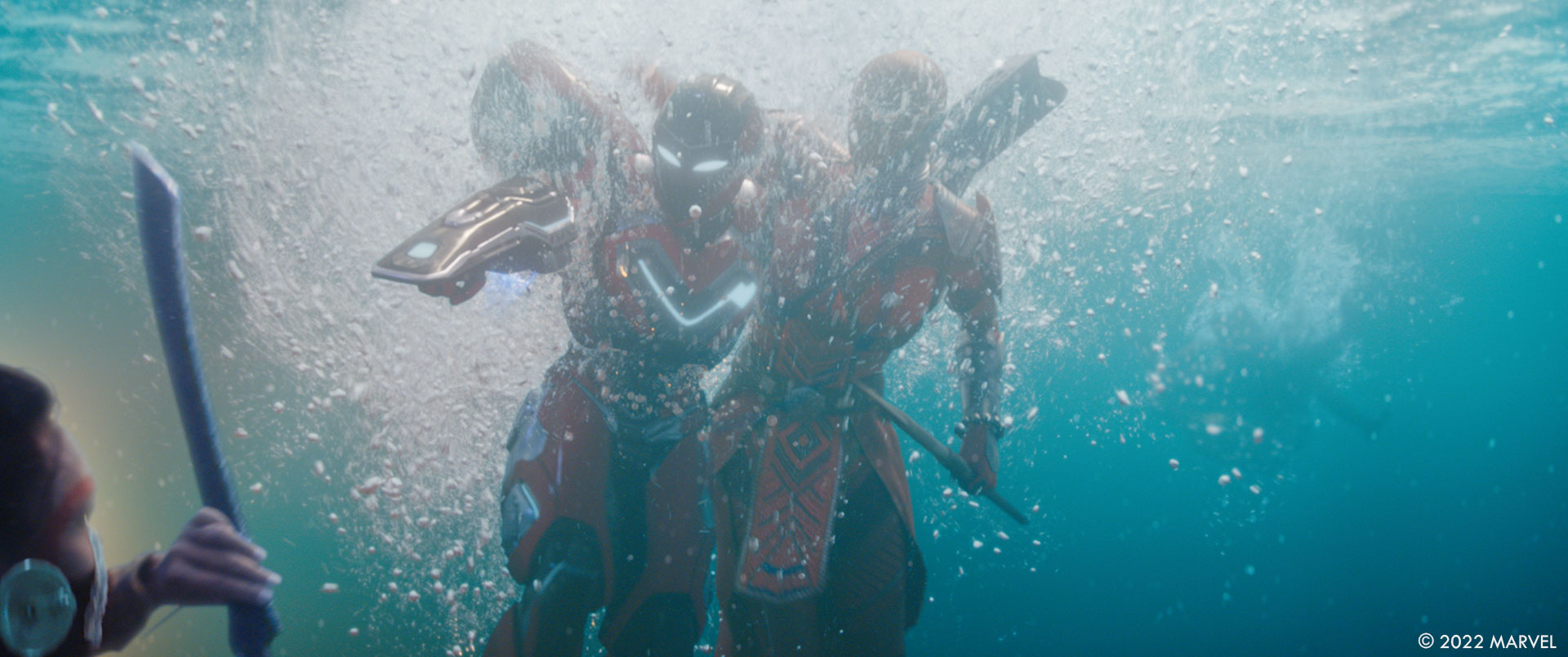
What is your favorite shot or sequence?
HT: For me, the wave and water work when the hydrobombs rock the Royal Sea Leopard are my favorite shots. To simulate and light those shots so nicely was remarkable. A close second would be the Orca tail flip. It seemed a little too much when I first saw it in previz, but in the context of the film and how beautifully done the effects and animation were, it really works.
What is your best memory on this show?
HT: I think it was just watching the first edit of the whole movie with temp everything and being blown away and wiping away more than a few tears. Seeing the big picture of what Ryan was trying to create was profound, and it clicked how important this movie was to both the fans and friends of Chadwick.
How long have you worked on this show?
HT: Having started on some animation tests in February and March of 2021 to finishing in October of 2022, I was on the show for about 18 months.
What’s the VFX shots count?
HT: We completed 439 shots in the final cut of the movie, but started much more along the way.
What was the size of your team?
HT: Our in-house team including our artists in Beijing, Hyderabad, Los Angeles, Montreal and Vancouver totaled about 450 artists at peak. Overall, it was an amazing sight in the final months of the movie. It was a team truly capable of moving mountains and it was humbling to see the dedication and effort that went into reaching the finish line.
What is your next project?
HT: Currently taking a well-deserved break and enjoying a lovely Holiday and New Year break that seems so rare these days.
A big thanks for your time.
WANT TO KNOW MORE?
Digital Domain: Dedicated page about Black Panther: Wakanda Forever on Digital Domain website.
© Vincent Frei – The Art of VFX – 2022




